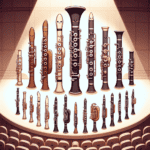Introduction to the Automatic Low E Mechanism
Clarinet playing has seen impressive advancements, making this classic instrument even more appealing to musicians across all skill levels. One such innovation, the clarinet automatic low E mechanism, is a clever addition that simplifies technique and enhances sound consistency. Curious about this mechanism and why it's creating buzz among clarinet enthusiasts? You're in the right spot!
How Does It Work?
For newcomers to the clarinet, it's important to note that producing a clear low E note, especially during fast-paced pieces, can be challenging. The automatic low E mechanism makes this easier by automatically adjusting specific keys as you play. This means less finger gymnastics and more focus on the music itself. Isn't that a great improvement?
With traditional clarinets, playing a clean low E often requires precise timing and even pressure when closing the keys. Any slight mistake can lead to unwanted sounds or inconsistencies. The automatic low E mechanism eliminates this issue by essentially storing the correct key positions for you. It's like having an invisible assistant ensuring everything sounds smooth. Cool, right?
| Feature | Traditional Clarinet | Clarinet with Automatic Low E Mechanism |
|---|---|---|
| Low E Production | Requires precise finger coordination | Automatically adjusts keywork |
| Ease of Play | Can be challenging, especially at high speeds | Simplified, allowing focus on musicality |
| Sound Consistency | May vary based on player's technique | Improved consistency across registers |
Notable Brands and Innovation
When exploring clarinets with this feature, players often look to manufacturers known for their innovative designs and reliability. Martin Freres Clarinets, for example, is frequently mentioned in discussions among dedicated players. While other companies offer similar systems, Martin Freres has built a solid reputation for skillfully combining traditional craftsmanship with modern innovations. Their careful attention to small yet significant design elements is highly valued by musicians who appreciate quality instruments.
The Playing Experience
Imagine playing a clarinet equipped with an automatic low E mechanism. Picture yourself navigating a challenging passage with frequent jumps to the lower register. Instead of worrying about hitting each note perfectly, you flow through the music effortlessly. It feels as if your clarinet is collaborating with you, not working against you. This added comfort can boost your confidence, something all musicians value.
Maintenance Tips
Caring for a clarinet with this mechanism isn't particularly difficult if you maintain it regularly. Whether you're practicing at home or performing on stage, regular cleaning and occasional check-ups by a professional will keep your instrument in top condition. Here's a tip: book regular appointments with a repair technician who knows these advanced mechanisms well. Don't assume your clarinet is fine without having an expert examine it periodically.
Who Benefits Most?
While experienced players appreciate this mechanism for its ability to enhance technical performance, beginners and intermediate clarinetists can gain a lot from it too. It's an excellent tool for improving finger coordination and building confidence. This support often motivates newer players, helping them progress more quickly.
Remember, though: having an automatic low E mechanism doesn't mean you can skip practice! This helpful feature complements proper technique and dedication; it doesn't replace them. When combined with diligent practice, it can significantly improve your playing.
Trying It Out
If you're thinking about trying or buying a clarinet with an automatic low E mechanism, visit your local music store or talk to clarinet experts. Play the instrument, listen carefully to how it sounds, and see how it feels as you play. You might be surprised at how personal and unique the right instrument can feel.
Conclusion
It's evident that this feature is more than just a trend—it truly enhances the clarinet-playing experience. Whether you're performing orchestral pieces or experimenting with jazz, the automatic low E mechanism provides valuable support without overshadowing your skills. This is what keeps the clarinet exciting and relevant in every performance.







